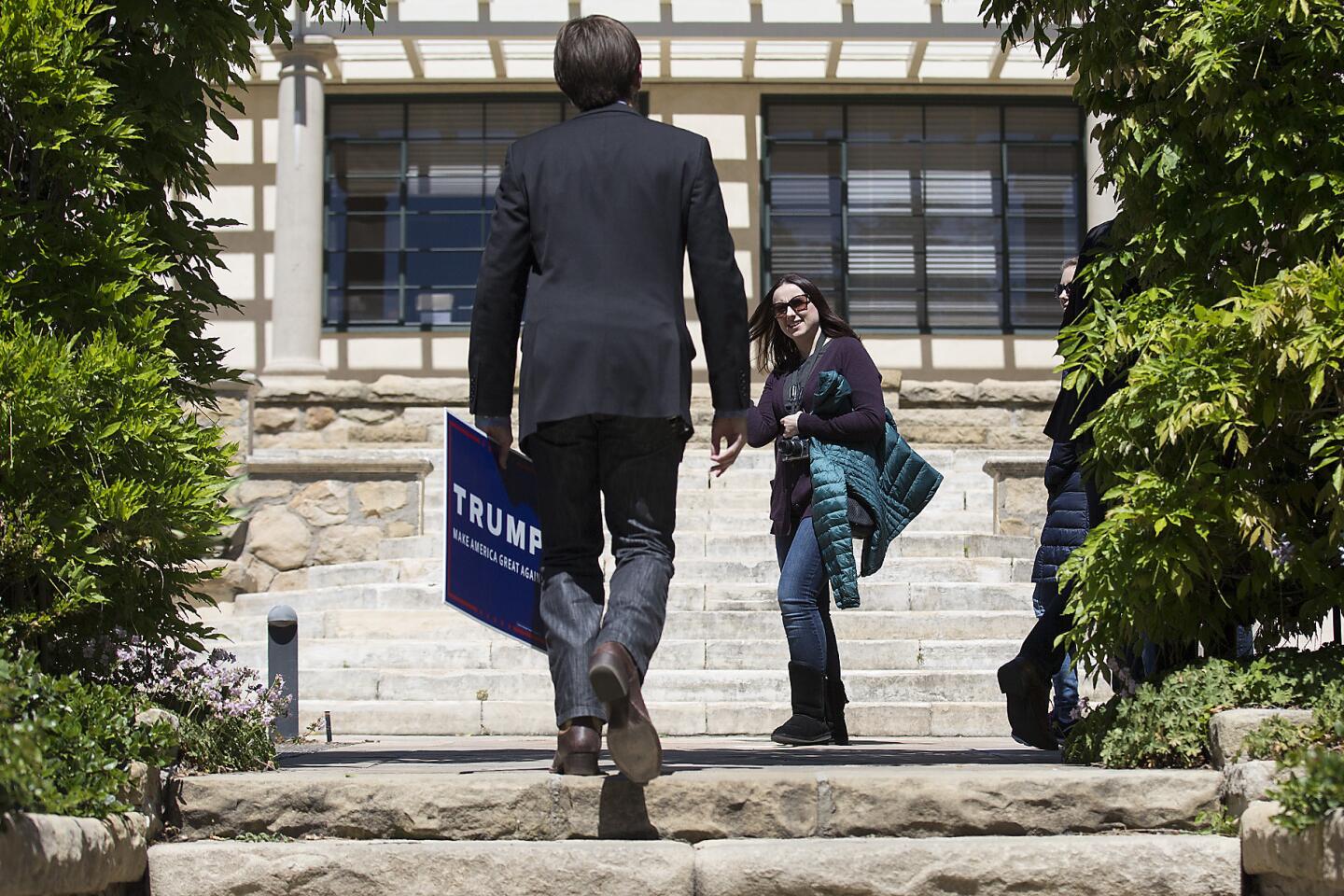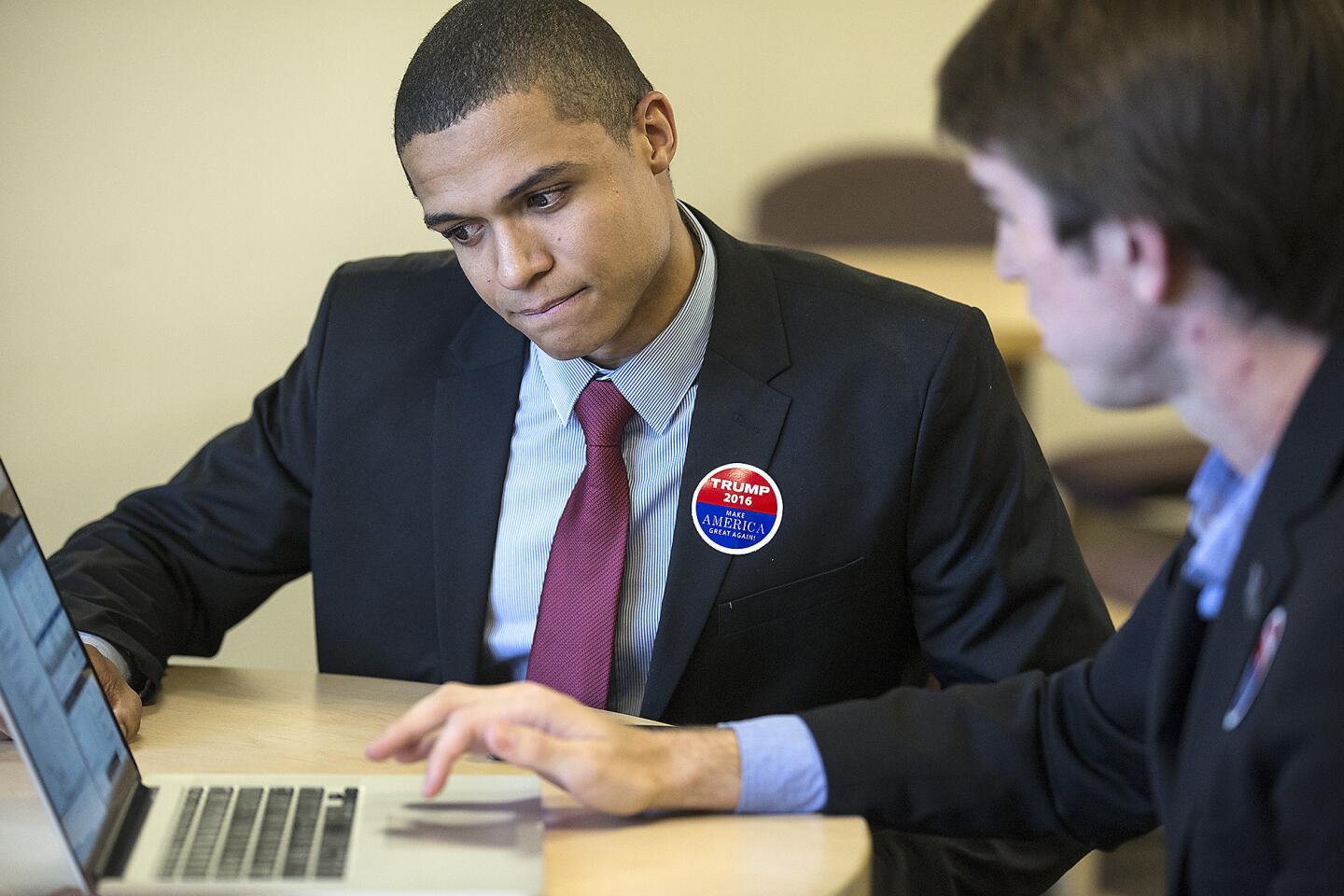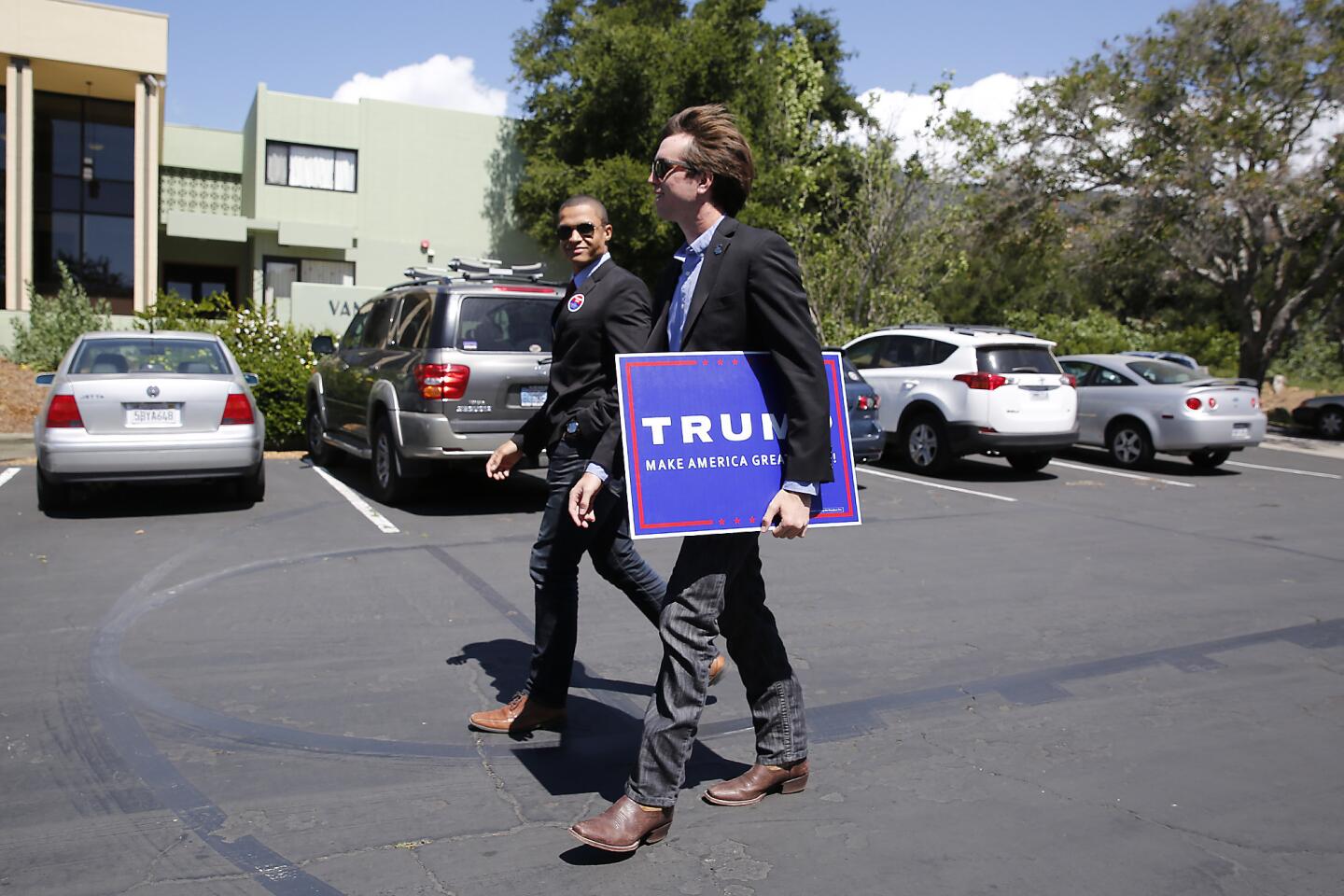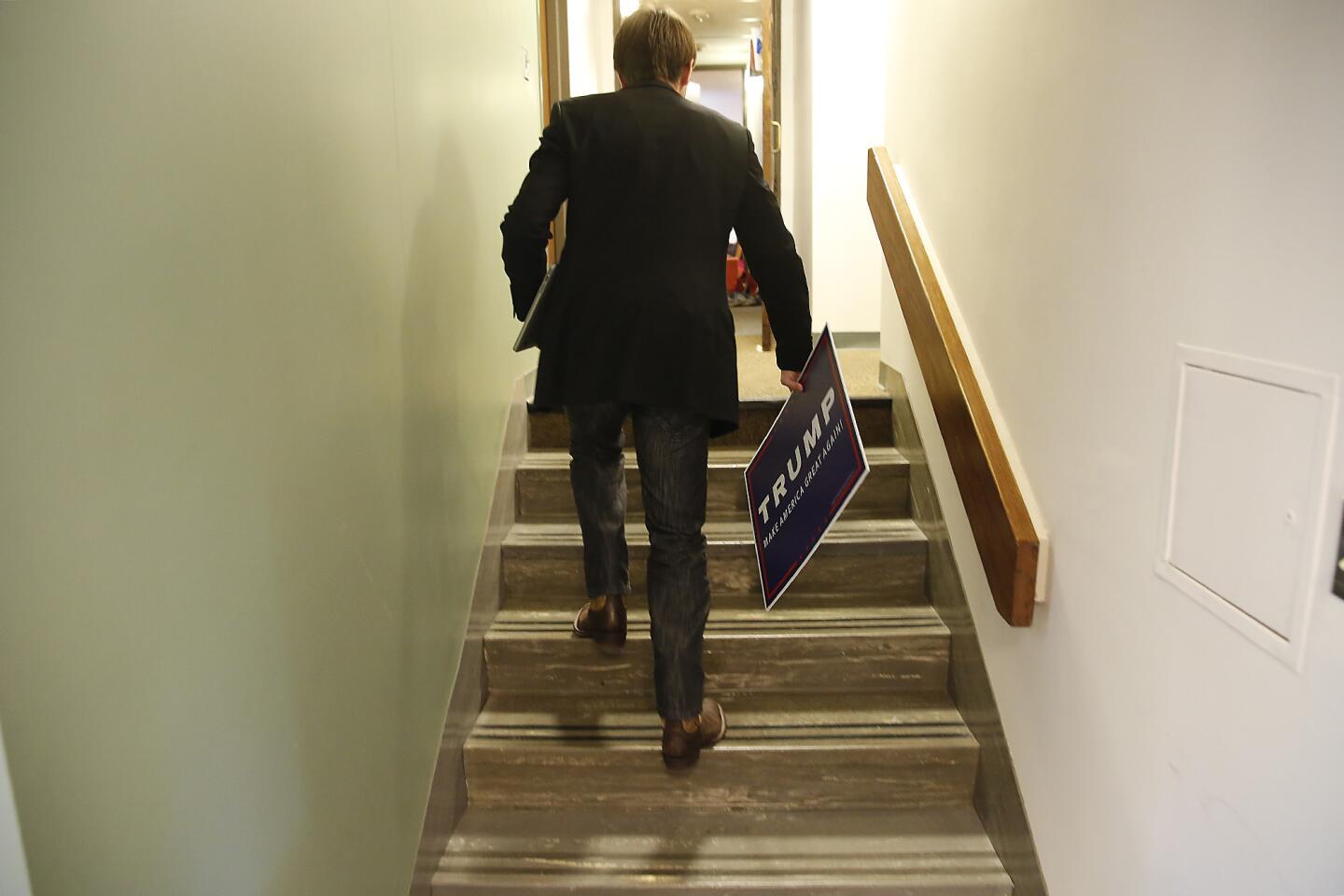On campuses across the country, students are standing up for Donald Trump
- Share via
Reporting from Santa Barbara — Hunkered behind a MacBook decorated with stickers that read “This laptop was brought to you by capitalism” and “TRUMP 2016,” Jake Lopez bounces T-shirt slogans off his friend Ian McIlvoy.
“Trumplicans,” he says, nodding with satisfaction. “I think it’ll take off.”
Lopez is the California director of Students for Trump. Working from his dorm at Westmont College, he helps marshal the thousands of students who are pounding out phone calls, taping up fliers and blanketing Twitter, Instagram and Snapchat in an effort to persuade their peers that Donald Trump is the man.
Although vastly outnumbered nationwide by left-leaning classmates chanting “Feel the Bern,” the youngest supporters of the GOP front-runner say they are similarly inspired by the hope of a radically different future and eager to support a leader who strikes them as anti-establishment and willing to speak his mind.
The verbiage that erupts from Trump’s stream-of-consciousness is not universally appreciated by students. Many say the very mention of his name can be hurtful, threatening or cause for intervention.
A Mexican American student at Scripps College in Claremont woke up to “#trump2016” scrawled on the whiteboard outside her dorm room. The student body president called it a “racist act.”
On the campus of Emory University in Atlanta, students protested when someone wrote in chalk: “Accept the Inevitable: Trump 2016.”
Jim Wagner, the president of the university, met with protesters and later sent an email to everyone on campus saying, in part, “They voiced their genuine concern and pain in the face of this perceived intimidation.”
Young Trump followers say such backlash against minority opinion, in a realm where liberal culture dominates, is part of what draws them to the cause.
“Today, there is a movement to silence differing views,” Lopez says. He argues that the increasingly common practice of students turning to “safe spaces” is really about sheltering students from ideas with which they disagree.
“That’s not what America is about,” he says. “Mr. Trump, he’s single-handedly bringing back freedom of speech. He’s enabled students to voice whatever we believe in a thoughtful way.”
::
Students for Trump began as a Twitter account in October in a dorm room at Campbell University in Buies Creek, N.C. Ryan Fournier, a freshman and early supporter of Rand Paul, was drawn to Trump’s blunt rhetoric and policies on border control and employment.
Between classes, homework and fraternity meetings, Fournier fired off tweets praising Trump and setting the record straight on what he considered misinformation.
“We love Muslims. We hate Islamic Extremism!” one tweet said.
In less than a month, Fournier had more than 14,000 Twitter followers. As GOP candidates like Carly Fiorina and Ben Carson dropped out of the presidential race, he gained thousands more. By December, he was devoting more than eight hours a day to spreading the word.
More than 5,000 students in 200 chapters in 38 states are publicly on board. Fifteen chapters have taken hold in California, on campuses including UC Santa Barbara and USC.
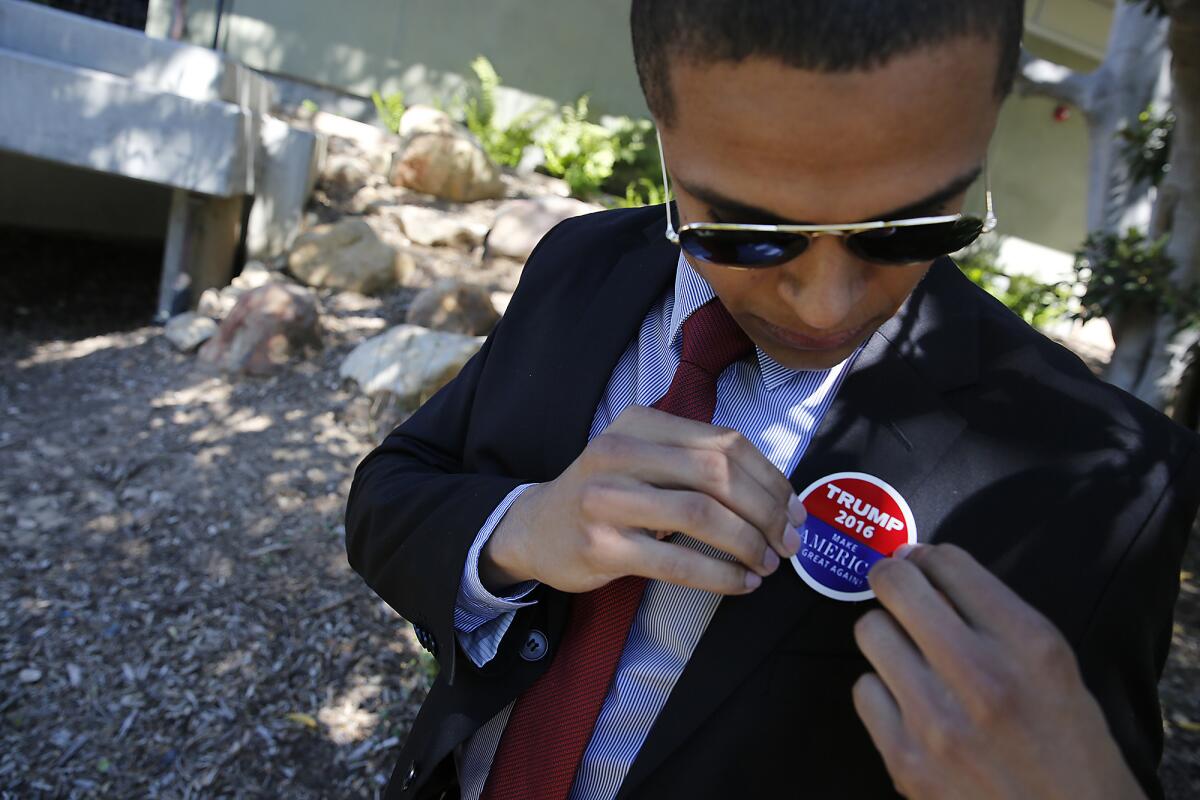
Ian McIlvoy, a Westmont College student who supports Donald Trump, affixes a Trump campaign sticker to his lapel.
I’m on team ABH -- anyone but Hillary. I realized Trump can really do it, and the other candidates really can’t.
— Ian McIlvoy, Westmont College student
For a volunteer-run enterprise, the operation is slick, with an HR department, a merchandise line and a team that’s constantly updating the website. Applicants for state director positions submit résumés and have their social media scrutinized.
Fournier’s take on the selection process would not have sounded out of place on “The Apprentice.”
“We don’t want to hire garbage,” the political science and pre-law major says. “It’s a very big job running a state.”
John Lambert, a sophomore studying wealth management at Campbell, is the business-savvy one in the leadership duo.
For Lambert, whose bio boasts that he founded a social media marketing company at age 16, Trump’s appeal lies in his business background and untraditional approach to politics.
“We’re tired of the typical ... failing politician that’s all talk and no action,” he says. “Mr. Trump is not about that. He’s going to hire people that can actually do the job, and that’s why we’re going to have a successful country.”
Like Trump himself, the young people who support him trigger strong reactions.
In a January news release, Fournier wrote: “We cannot forget our haters, whose messages give us a good laugh. As Taylor Swift would say, “Haters gonna hate, hate, hate, hate, hate.’ ”
Looking ahead, the team is honing its ground operations in states like Wisconsin, New Jersey and California.
“We want to match what Bernie Sanders is doing on the Democratic side,” Lambert says.
The team hired Lopez, who grew up in the Central Valley town of Taft, to establish more chapters and recruit classmates like McIlvoy, who’s volunteering as state treasurer on top of working 20 hours a week at the library to pay off his student loans.
“I’m on team ABH — anyone but Hillary,” McIlvoy says. “I realized Trump can really do it, and the other candidates really can’t.”
Their strategy, they say, is to get classmates talking.
McIlvoy, who identifies himself as half black, dressed up as Carson for Halloween, and Lopez recently launched a satirical petition calling for “GPA redistribution” to make a point about progressive tax structures that he thinks “punish success.”
“Our pitch was: Some students at the top have too much, and some students at the bottom have too little. So we should redistribute some of the top earners, the 4.0s, to lower students so everyone can graduate equally,” Lopez says. “That provoked people, and we had a lot of good conversations.”
His last name raises eyebrows among those who see Trump’s accusation that Mexico is sending rapists across the U.S. border — which he’d protect with a wall whose height seems to grow with every debate. Detractors point to that plan as evidence that Trump is hostile to Latinos, if not a flat-out racist.
Lopez notes that his great-grandfather was Mexican but says he considers himself “an American, a Californian, a Christian.”
“Not all Hispanics hate Trump,” he says.
And the more he comes out as a supporter, the more other students do too, he says.
“I have about 25 chapter requests in my in-box right now that I have not been able to get to. The support is out there, and we’re trying to get them mobilized and speaking up.”
Which is not to say that Trump — who has insulted women, minorities and other conservatives, among others — is any less polarizing a candidate on campuses than he is within the Republican party itself.
“We’re just not attracted to that,” said Kerida Moates, president of the UC Berkeley College Republicans. Her group, she says, has made huge strides in persuading the liberal campus mainstream that “we’re just regular people who have different ideas about how to make our economy work.”
Then Trump comes along,” she says, “and suddenly all Republicans are being framed as racist again; all Republicans must be sexist. And it’s actually taking us backward in breaking those stereotypes.”
::
Students who support Trump likely will remain a lonely group on campus, says Dan Schnur, director of the Jesse M. Unruh Institute of Politics at USC.
Trump, he says, continues to attract working-class supporters who don’t have college degrees and are anxious about job security in a modern economy that requires technology and information-based skills.
But Schnur does see why some college-educated millennials might be drawn to Trump.
“What Trump and Sanders have both done very effectively is mount a strident criticism against the traditional political process,” he says. “If you’re a young person and you don’t feel like politics-as-usual has a place for you, there’s a natural temptation to align with a candidate that can dramatically upend that system.”
The Republican party itself is largely to blame for this insurrection by ignoring that even young fiscal conservatives are becoming more “progressive” on social issues like gay marriage, says Kei Kawashima-Ginsberg, director of CIRCLE, a research hub at Tufts University that studies youth voting.
“Trump is a lesson in that,” she says.
It will be interesting to see how the Republican youth vote plays out come election time, says John Della Volpe, director of polling at Harvard University’s Institute of Politics.
“Young voters engage more often when things are tangible. ... And you’re seeing very tangible differences right now between what a Donald Trump presidency would look like, what a John Kasich presidency would look like and what a Ted Cruz presidency would look like,” Della Volpe says.
“I’ve been in focus groups where I ask a young voter if they’re going to vote, and they’ll say ‘No, it doesn’t matter. They’re all a bunch of old white men; they’re all the same.’ That’s clearly not the case here.”
Back at Westmont, Lopez and McIlvoy are working hard to persuade their peers to vote for the right old white guy.
Donning suit jackets and Trump stickers, they walk across campus, drawing curious glances and friendly handshakes.
They’re relieved, they say, that coming out as Trump supporters hasn’t taken a toll on their social lives. Debates with friends have been lively, and they’re excited to recruit more students publicly as the political campaigns march closer to California.
“We’re hoping to get people involved, even if they’re against us. Come talk; be a part of the conversation. That’s what America is about,” Lopez says.
“Patrick Henry said, ‘I may not agree with what you say, but I will defend to the death your right to say it,’ and that’s what’s important to us.”
Twitter: @RosannaXia
More to Read
Sign up for Essential California
The most important California stories and recommendations in your inbox every morning.
You may occasionally receive promotional content from the Los Angeles Times.

